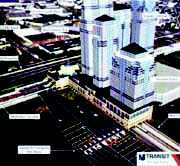In a move that local officials hope will help them keep a handle on dramatic changes to Secaucus over the upcoming decade, the Town of Secaucus, the New Jersey Meadowlands Commission (NJMC) and New Jersey Transit will move forward with conceptual plans for a possible redevelopment project for the south side or “back road” section of Secaucus.
“This may mean the biggest changes Secaucus has ever seen,” said Mayor Dennis Elwell. On Nov. 25, the New Jersey Meadowlands Commission agreed to expend up to $80,000 to allow New Jersey Transit to conduct a Transit Village Study for areas near the Secaucus Transfer Station.
Such a designation – and the increased access to state funding it brings – requires a comprehensive redevelopment plan built around transportation centers, with a mix of new housing, retail space, and office space within a half mile of train stations and bus depots.
The New Jersey Transit Village Initiative already assists the communities of Morristown, Pleasantville, Rutherford, South Amboy, and South Orange in leveraging more private-sector investment for redevelopment.
Under the initiative first proposed in the administration of Gov. Christine Whitman, the New Jersey Department of Transportation and New Jersey Transit are partnering with other state agencies – the New Jersey Economic Development Authority, the Department of Community Affairs, the Office of State Planning, the New Jersey Redevelopment Authority, and the New Jersey Housing and Mortgage Finance Agency, to provide the technical assistance and resources to help communities implement development that will help develop neighborhoods around transportation hubs.
Additionally, with the establishment of the Transit Villages, these communities will be given priority consideration for funding from NJDOT’s Local Aid for Centers program, the Transportation Enhancements program, and bicycle and pedestrian projects.
The program is designed to generate development and investment around passenger rail stations.
“Secaucus as we know it is about to change because of the Secaucus Transfer Station,” said. “This area has the potential to explode, and I would rather not see an explosion. I would like to see a blossoming of South Secaucus. This plan would allow us to have some control over what will be developed in that area,” said Elwell.
Transit Villages is an approach that helps communities layer housing, commercial centers, retail outlets, entertainment and pedestrian-friendly development, and landscapes around transit centers, like train stations, in a way that makes it possible for more people to live and work there.
“Once that train station opens, people will be coming home later at night,” Elwell said. “We do not want people stepping out into a warehouse district. This will allow for us to make sure there is orderly development in and around the train station, as things develop out.”
This could mean the construction of a light rail line down the middle of Meadowlands Parkway or even a new bridge for traffic over the Hackensack River near Harmon Cove. But most importantly this will mean a massive transformation of south Secaucus, an eventual elimination of warehouses and the development of a whole new retail approach in the area.
“Over time you might even see a whole second downtown district there,” Elwell predicted.
A study of what the area needs
The study will look at the area and its possible uses, as well as what kind of activity the area can expect at various times of day, week or season.
In recent years, transit villages have become a hallmark of applied smart-growth principles, the concept being to keep people off the roads by housing families and businesses within walking distance of transportation.
The Transit Village program is part of the state Department of Transportation. While there are numerous factors in that shift, the desire to live closer to public transportation has become a key factor, residents, real estate agents, developers, and state and local officials said. Transit ridership has been increasing nationwide, according to the U.S. Bureau of Transportation
In New Jersey, there has been a sharp shift back towards urban living and older suburbs. According to the 2000 Census, six New Jersey counties in the industrialized northeast portion of the state saw population growth of 6.9 percent from 1990 to 2000.
This trend is expected to grow as NJ Transit completes projects including the Secaucus Transfer Station that will allow rail passengers from four NJ Transit lines to connect with other lines with direct access to New York City. The station is expected to open in 2003.
Secaucus will have a say in its own future
What makes the possible Transit Village in Secaucus different from elsewhere is the “stakeholder committee” that will have an equal say in the development choices.
“This committee will be made up of prominent local residents,” Elwell said. “And we’ve been assured that the committee will have the ability to sit in on discussions, look at the plans and make adjustments.”
Most likely, Councilman Christopher Marra will sit on this committee because of his extensive background in redevelopment and his work on the Transit Village in Morristown. Other appointees will likely include a member from Harmon Cove boards as well as other key decision-makers in the community.
The Transit Village concept will allow for orderly development as well as the acquisition of old warehouses for redevelopment.
“Rather than having some developer from another part of the state coming into Secaucus to tell us what the part of town will look like, we will be able to pick the developer and tell that developer what we want to see there,” Elwell said.
Whereas the study will take about three months, the redevelopment could take as long as 10 or 15 years to complete, but it will create a whole new Secaucus.
“But we have to be careful that what gets planed does hurt the current Secaucus,” Elwell said.
